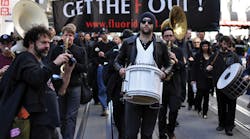Resistance to water fluoridation persists, often due still to the same startling lack of facts
By Cathy Hester Seckman, RDH
It's been 64 years since the U.S. Public Health Service recommended adding controlled doses of fluoride to municipal drinking water.1 It was controversial then and remains controversial today. Environmentalists, pseudoscientific groups, and well-meaning citizens have fought for years to discredit water fluoridation, blaming it for everything from arthritis to cancer to thyroid disease.
On the other side of the debate, the U.S. Public Health Service is joined by the American Dental Hygienists' Association, the American Dental Association, the American Academy of Pediatric Dentistry, the American Medical Association, the Centers for Disease Control and Prevention (CDC), and other reputable scientific institutions in lauding fluoridation as one of the best public health ideas we've ever had.
Silliness?
In the history of fluoridation, the debate has sometimes verged on what, today, seems like silliness. An entertaining article by Jesse Hicks, a Pennsylvania State University professor, outlines the history of fluoridation controversy in Chemical Heritage Magazine.2
In 1942, early fluoride researcher H. Trendley Dean wrote an article for Collier's, called "The Town Without a Toothache," about the 3-ppm concentration of natural fluoride in Hereford, Texas.2
In 1945, Grand Rapids, Michigan, hosted a pilot project for fluoridation of its municipal water supply. Most residents were in favor of the project, but some apparently decided in advance that it was bad idea. A newspaper had mistakenly reported the trial would begin in early January. Soon after the first of the year, city officials were fielding reports of "sore gums and peeling tooth enamel." The trial did not actually begin until January 25. When the trial ended in 1959, there was a 55.5% reduction in cavities among Grand Rapids children.2
With widespread support, public water fluoridation was available to five million Americans by 1951 and 41 million Americans by 1960. Opposition continued, however, from groups that included the Fluoride Action Network, Citizens for Safe Drinking Water, and the Sierra Club.2
In 1949, at an election in Stevens Point, Wisconsin, a fluoridation proposal was defeated after local poet Alexander Y. Wallace called fluoride a poison. When the city council tried to push fluoridation through secretly in 1959, Wallace published a pamphlet featuring a skull and crossbones, urging voters to "Get the Poison Out of Our Drinking Water." Fluoridation was again rejected.2
The 1959 publication of Aldous Huxley's Brave New World added fuel to antifluoridation efforts. A publication called the Dan Smoot Report suggested that insidious drugs, like those in the novel, could be given to an entire population in the same way fluoride was being delivered. Also that year, another dissenting group published Robotry and Water: A Critique of Fluoridation.2
The John Birch Society liked Dan Smoot's proposition, as did the Independent, a journal of "patriotism for vigilant constitutionalists." An edition of the journal published on March 31, 1960, said, "Former Communists have stated that fluoridation is . . . a method of Red Warfare." Carrying that theme forward, in the 1964 film Dr. Strangelove or: How I Learned to Stop Worrying and Love the Bomb, a character labeled fluoridation a "monstrously conceived and dangerous Communist plot."2
Ongoing opposition
Since the 1960s, community water fluoridation has faced continuing opposition. Scientists believe their case for fluoride's safety has been proven; opponents provide statistics that can be skewed, ambiguous, or incomplete. Fluoride opponents remain able to sway significant numbers of people who have no trust in or knowledge of scientific studies. In 2000, for instance, fluoride referendums failed in 14 of 23 cities where they were proposed.3
One of the recent antifluoridation salvos came from television personality Dr. Mehmet Öz (known as Dr. Oz) of the Dr. Oz Show and environmental activist Erin Brockovich. In the episode, which aired February 1, 2016, Brockovich called fluoride "just another toxic compound."4 She stated that the CDC had originally set the optimal fluoride amount to be added to public water systems at 1.7 mg/liter, then last year reduced that number to 0.7 mg/liter.4 Her statement was wrong by several milligrams, but Dr. Oz didn't correct her. The actual 1962 recommendation was for 0.7 mg/liter to 1.2 mg/liter.5 All that has changed is the range. The new recommendation is for the bottom number of the range only, and it takes into account that fluoride is now available in over-the-counter sources like toothpastes and rinses.5
During the same episode, Oz stated that "much of Europe" has rejected water fluoridation.4 He did not explain that fluoridated water is available to 12 million people in Great Britain, Ireland, and Spain; fluoridated milk is used in eastern Europe; and fluoridated salt is used throughout Germany and Switzerland, which have some of the lowest rates of caries in Europe.6 The reason water fluoridation is not more popular in Europe is because there are thousands of drinking water sources.6
A "quick fact" featured on the Fluoride Action Network (FAN) website in February 2016 stated that "97% of western Europe has rejected water fluoridation" (emphasis theirs).7 The "quick fact" link leads to a webpage that says that 97% of western Europeans drink nonfluoridated water.8 Nowhere on the page does FAN support the claim that 97% of Europeans actually "rejected" the idea.8
It's this type of misinformation that fluoridation opponents use as ammunition. FAN, one of the most well-known antifluoride groups, claims more than 75,000 members. According to FAN, more than 150 communities worldwide have rejected fluoridation since 2010.7
The Children's Dental Health Project, in contrast, tells us that fluoridation has indeed been rejected by some U.S. communities, but the number of communities accepting fluoridation has increased steadily over the past decade.9 According to 2014 statistics from the Pew Charitable Trusts, 74.6% of US citizens in each state, on average, have access to fluoridated water.10 In my state, Ohio, the percentage of residents who receive fluoridated water is 92.2%.10
FAN also states that fluoride has been linked with osteosarcoma, citing a 2006 study by Bassin et al., from the Harvard School of Dental Medicine.11 Here's a concluding quote from the actual study: "Our exploratory analysis found an association between fluoride exposure in drinking water during childhood and the incidence of osteosarcoma among males but not consistently among females. Further research is required to confirm or refute this observation," (emphasis mine).12
The American Cancer Association also addressed the question about whether fluoride might be linked to cancer. Its website reports that in 2006, the National Research Council updated a 1993 review of the subject. The conclusion was that "evidence on the potential of fluoride to initiate or promote cancers, particularly of the bone, is tentative and mixed."13
Another FAN claim is that fluoride exposure "may also lead to increased insulin resistance."14,15 FAN cites a study that was published in the Chinese Journal of Endemiology in 2000.16 A look at the research reveals that the population studied comprised adults between the ages of 40 and 68 who lived in a remote village with water naturally high in fluoride.16 No low-fluoride water or water improvement was available to the villagers.16
For a different viewpoint, consider this article in the Journal of Dental Research, published in July 2015: "Low-level fluoride exposure increases insulin sensitivity in experimental diabetes." For purposes of the study, diabetes was induced in rats, and the rats were then given either 0, 10, or 50 mgF/liter. The results suggested that low levels of fluoride might enhance glucose stability.17
It should be pointed out that we're still waiting for the final word on community fluoridation. Research and reviews of research continue, and the optimal amount of added fluoride may change again. These are the current facts, though, and it's our responsibility as dental health professionals to understand and present a complete picture of the ongoing fluoridation controversy to our patients. RDH
Where to turn for supportive information
It's easy to see the reasons for community resistance to municipal water fluoridation. Vague, incomplete, or misleading headlines are all that some people need to form an opinion. If your patients raise questions about the safety and/or efficacy of community fluoride, be sure they have all the facts-not just some of them.
A good website to recommend is ilikemyteeth.org, which is run by the Campaign for Dental Health (CDH), a network of oral health advocates including more than 120 partner organizations-such as the American Academy of Pediatrics, the American Association for Community Dental Programs, the American Association for Dental Research, the American Association of Public Health Dentistry, and too many others to list.
On the webpage, ilikemyteeth.org/fluoridation/dangers-of-fluoride, consumers can view antifluoridation claims one by one: "Fluoride causes cancer," for instance, or "Fluoride is a by-product of the phosphate fertilizer industry." Following each claim is a list of facts (in plain language) that tell the complete story behind each claim.
Cathy Hester Seckman, RDH, worked in dentistry 32 years, including 12 years as a pediatric hygienist. Officially retired from clinical hygiene, she still fills in occasionally at the same pediatric practice. She is a frequent contributor to dental magazines, works part-time as an indexer, and is the author of two novels, more than a dozen short stories, and an Arcadia Publishing history of her hometown.
References
1. United States Department of Health and Human Services Federal Panel on Community Water Fluoridation. U.S. Public Health Service Recommendation for fluoride concentration in drinking water for the prevention of dental caries. http://www.publichealthreports.org/documents/ PHS_2015_Fluoride_Guidelines.pdf. Published July-August 2015.
2. Hicks J. Pipe dreams: America's fluoride controversy. Chemical Heritage Magazine website. http://www.chemheritage.org/discover/media/magazine/articles/29-2-pipe-dreams-americas-fluoride-controversy.aspx?page=1. Published 2011.
3. Kliff S. A brief history of America's fluoride wars. Washington Post website. https://www.washingtonpost.com/news/wonk/wp/2013/05/21/a-brief-history-of-americas-fluoride-wars/. Published May 21, 2013.
4. Erin Brokovitch [sic] and Dr. Oz [video clip]. YouTube. Originally aired on: "Breaking news: The Zika virus: A public health emergency in the making?"; The Dr. Oz Show; February 1, 2016. https://www.youtube.com/watch?v=HBHwQ-jfTAY. Published February 10, 2016.
5. Bernstein L. U.S. updates water fluoridation guideline for the first time in 53 years. Washington Post website. https://www.washingtonpost.com/news/to-your-health/wp/2015/04/27/u-s-updates-water-fluoridation-guideline-for-the-first-time-in-53-years/. Published April 27, 2015.
6. Peterson A. Question: European countries have rejected fluoridation, so why should we fluoridate water? Wisconsin Dental Association website. http://www.wda.org/wp_super_faq/european-countries-have-rejected-fluoridation-so-why-should-we-fluoridate-water. Published March 8, 2013.
7. Communities that have rejected fluoridation since 2010. Fluoride Action Network website. http://fluoridealert.org/content/communities_2010.
8. Statements from European health, water, & environment authorities on water fluoridation. Fluoride Action Network website. http://fluoridealert.org/content/europe-statements.
9. The Children's Dental Health Project. Fluoridation advocacy: Pew's contributions and lessons that emerge. http://fluoridealert.org/wp-content/uploads/pew.july-2015.pdf. Published July 2015.
10. The Pew Charitable Trusts. Community water fluoridation: The top 10 and bottom 10. http://14703-presscdn-0-93.pagely.netdna-cdn.com/wp-content/uploads/2014/03/CWF_Map_2013_CDC_data_920.jpg. Published January 2014.
11. Cancer. Fluoride Action Network website. http://fluoridealert.org/issues/health/cancer.
12. Bassin EB, Wypij D, Davis RB, Mittleman MA. Age-specific fluoride exposure in drinking water and osteosarcoma (United States). Cancer Causes Control. 2006;17(4):421-428. http://www.ncbi.nlm.nih.gov/pubmed/?term=Cancer%2C+Causes+%26+Control%2C+2006+%2B+Bassin.
13. Water Fluoridation and Cancer Risk. American Cancer Association website. http://www.cancer.org/cancer/cancercauses/othercarcinogens/athome/water-fluoridation-and-cancer-risk. Revised July 28, 2015.
14. Connett M. Fluoride & insulin. Fluoride Action Network website. http://fluoridealert.org/studies/diabetes02. Updated April 2015.
15. García-Montalvo EA, Reyes-Pérez H, Del Razo LM. Fluoride exposure impairs glucose tolerance via decreased insulin expression and oxidative stress. Toxicology. 2009;263(2-3):75-83. http://fluoridealert.org/studytracker/15445.
16. Xie YP, Ge XJ, Jiang YT, et al. Clinical study of effect of high fluoride on the function of the pancreatic islet B cells. Chin J Endemiology. 2000;19(2):84-85. http://www.fluoridealert.org/wp-content/uploads/xie-2000.pdf.
17. Lobo JG, Leite AL, Pereira HA, et al. Low-level fluoride exposure increases insulin sensitivity in experimental diabetes. J Dent Res. 2015;94(7):990-997. http://www.ncbi.nlm.nih.gov/pubmed/25861800.







